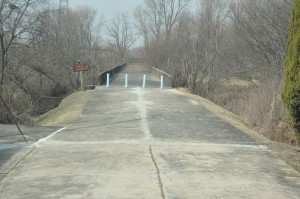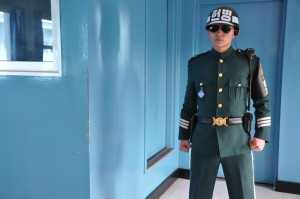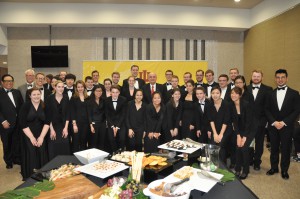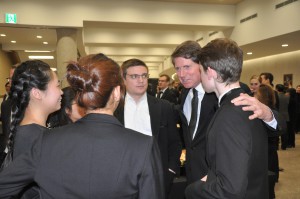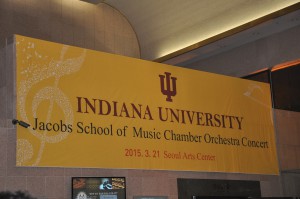A day of history and harmony
I had one foot in North Korea today.
While the student musicians in the IU Chamber Orchestra were busy practicing for the final performance of their historic tour of Seoul, members of the IU delegation here to support them took an early-morning trip to one of the last real remnants of the Cold War and a place that former U.S. President Bill Clinton once famously described as “the scariest place on earth.”
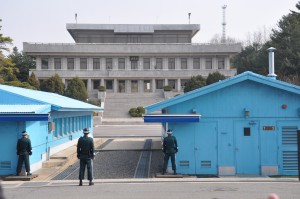
Panmun Hall, the main building managed by the North Koreans in the Joint Security Area of the Korean Demilitarized Zone. The blue United Nations houses straddle the demarcation line between South and North Korea.
About 2.5 miles wide, the Korean Demilitarized Zone –or DMZ – effectively divides North and South Korea on an angle around the legendary 38th parallel north. Established at the end of the Korean War in 1953, it is the most heavily fortified border in the world, its landscape dotted with watchtowers and guard posts, barbed wire and bunkers, landmines, tanks and tunnels. On either side of this rugged piece of empty no-man’s land stand thousands of troops from both sides of a conflict that hasn’t technically ended (the two nations have never arrived at a final “peaceful settlement”) and continues to keep soldiers on the highest of possible alerts should war ever break out again.
As mentioned on several occasions by our U.S. soldier tour guide, who, in pure coincidence, just so happened to be a 20-year-old Hoosier from New Albany, Ind., conflict can break out at any time, and, indeed, the DMZ has experienced a considerable share of deadly skirmishes over its more than a half-century in existence. Most famously, in 1976 two U.S. Army officers were brutally killed by North Korean soldiers in the Joint Security Area of the DMZ, where IU’s delegation was today, in what is now known as the “Axe Murder Incident.” Another incident took place in 1984, when a Russian tourist ran across the military demarcation line shouting that he wanted to defect. Violent outbursts along the DMZ, initiated by North Korean hostilities, reportedly killed more than 500 South Korean and 50 U.S. soldiers between 1953 and 1999.
At the DMZ, stone-faced soldiers from both sides literally square off against one another. At the Joint Security Area – or JSA – where all joint negotiations have been held since 1953, there are soldiers stationed along what’s known as “Conference Row,” keeping careful watch on one another for even the slightest threatening action or gesture. To this end, we in the IU delegation are repeatedly told to keep our head and hand movements to a minimum, any “scoffing” invisible and our camera lenses aimed low to avoid provocation. We’re also asked to sign disclaimers at the start of our tour, stating that we recognize our safety cannot be guaranteed.
Today’s tour took us to DMZ areas where the quiet calm belied the true tension in the air. Those areas included the southern side of the JSA, where we were led into one of the trademark blue United Nations buildings that straddle the demarcation line and where one can briefly step into one of the world’s most closed-off countries, while U.N. forces steadfastly guard the doors. Once back outside, we were given a direct view of Panmun Hall, the main building managed by the North Koreans in the JSA. Its gray steps and three stories confront South Korea’s Freedom House.

IU President Michael A. McRobbie poses for a picture with an Indiana serviceman who led the IU delegation’s tour of the DMZ.
Our tour also brought us to the site where the “Axe Murder Incident” took place, now marked with a monument, and another area that offered us a high-up view of the infamous “Bridge of No Return,” which crosses the demarcation line between North and South Korea. Used for prisoner exchanges at the end of the Korean War, its name reflects how many prisoners captured by the U.S. didn’t want to return home. When brought to the bridge, which has not been used for prisoner exchanges since 1968, prisoners were offered the choice to remain in the country of their captivity or cross over to the other country. If they chose to cross the bridge, however, they would never be allowed to return. (A side note: During his 1993 visit to South Korea, President Clinton walked on the bridge, chatting with military personnel stationed just a few feet from North Korea and venturing closer to that country than any other president ever had.)
Finally, we made the trek back to our starting point, Camp Bonifas, the military post named in honor of Captain Arthur Bonifas, one of the two Americans killed in the axe murder. On our way, we scanned the sweeping brown fields to find world’s third-tallest flagpole, which flies a North Korean flag over Kijong-dong, a peace village situated in the northern half of the DMZ, one of two villages permitted to remain in the zone; the other is the South Korean village of Daeseong-dong.
Up until 2004, massive loudspeakers mounted on some of the buildings in Kijong-dong used to blast loud North Korean propaganda messages toward the south. On the hour-long trip back to Seoul, I could only imagine how the South Korean and U.S. soldiers who were here back then felt having to hear those sounds day after day, just as I wondered what it must be like to live in an area of the world that is continually on the brink. As one IU alumnus told me last night, somewhat jokingly, but also with some solemnity, “If Americans really understood just how close we are to danger, they might never come to Seoul.”
A harmonious performance
Hours after we’d departed the DMZ, we had the pleasure of hearing far more pleasant sounds when the IU Chamber Orchestra took the stage at the chamber music hall of the majestic Seoul Arts Center, Korea’s equivalent of Manhattan’s legendary Lincoln Center. Will all due respect to each of the orchestra’s terrific appearances earlier in the week, its members saved their best performance for last, rising to the historic occasion with a concert that wowed an enthusiastic sold-out audience. That audience included more than 170 IU Jacobs School of Music alumni, as well as families and friends of the seven members of the orchestra for whom this trip is a homecoming.
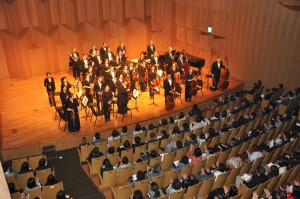
Members of the IU Chamber Orchestra culminate their tour of Korea with a sold-out performance at Seoul Arts Center.
The students sounded so good, so remarkably seasoned and poised, and so seemingly undaunted by their storied surroundings. (Approximately 40 million visitors have walked through the doors of the center, which is celebrating its 25th anniversary this year.) Fittingly, for their final piece on this historic tour of Seoul, they chose to perform the traditional Korean folk song that they unveiled earlier in the week at Seoul National University. The piece was arranged by Jacobs School of Music alumnus and current master’s composition student Ari Fisher, who, amazingly, is only 23 years old.
Most of the three dozen students who performed here at Seoul Arts Center are even younger than Fisher, and it was clear watching them in three of their four performances in Seoul, talking to a few of them at a post-concert reception last night and following their adventures on their own blog site, that they were having the time of their lives. If they felt the burden of being ambassadors for the Jacobs School of Music, Indiana University and the state of Indiana, it certainly didn’t show.
”These young people made us so proud tonight,” said Jacobs School of Music Dean Gwyn Richards. “They traveled together, made music and new memories together, and all the while served as great ambassadors of Indiana University. So rich and filled with promise is this moment – a moment that together they defined.”
In greeting the audience from the stage prior to the concert, IU President Michael A. McRobbie referenced Daniel Barenboim, a Nobel Peace Prize-nominated conductor and pianist. In 2013, Barenboim led a four-night presentation of the complete Beethoven symphony cycle at Seoul Arts Center. The next day he performed a peace concert in Imjingak on Korea’s Liberation Day. “Music may not be a problem solver,” McRobbie quoted Barenboim as saying, “but it can be a source of passion and interest that facilitates dialogue.”
Indeed, the hope by all in the audience this evening was that the performance by IU’s remarkable student musicians would serve to unite us all, inspire deeper discussion and make the world more harmonious.

IU’s student musicians enjoy a well-earned rest after performing four historic shows in Seoul over five nights.
Tags: Ari Fisher, Axe Murder Incident, Bridge of No Return, DMZ, Gwyn Richards, Indiana University, IU alumni, IU Alumni Association, IU Chamber Orchestra, Jacobs School of Music, Joint Security Area, JSA, Korean Demilitarized Zone, Korean War, Michael A. McRobbie, North Korea, Seoul, Seoul Arts Center



